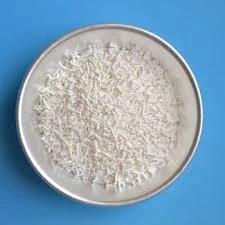
Concentrated Glacial Acetic Acid - Properties, Uses, and Safety
Understanding Concentrated Glacial Acetic Acid
Concentrated glacial acetic acid is a vital chemical that plays a crucial role across various industries and applications. As a clear, colorless liquid with a characteristic pungent smell, glacial acetic acid is essentially the pure form of acetic acid, containing approximately 99-100% acetic acid. It is known for its ability to dissolve many organic compounds and has a high boiling point, which makes it unique compared to other acids.
Chemical Properties and Structure
The chemical formula of glacial acetic acid is C₂H₄O₂, showcasing its composition of carbon, hydrogen, and oxygen. The structure consists of a carboxylic acid group, which gives it its acidic properties. Under standard conditions, glacial acetic acid can exist in a solid state below 16.6°C. This solid state results in its name glacial, referring to its ice-like appearance when frozen. The melting and freezing points of glacial acetic acid are crucial for understanding its behavior in different environments, especially in industrial processes.
Uses in Industry
One of the primary applications of concentrated glacial acetic acid is in the manufacturing of synthetic fibers, particularly acetate fibers, which are widely used in textiles. Additionally, it serves as a key ingredient in the production of various chemicals, including acetic anhydride and acetate esters, which are essential in producing plastics and solvents.
In the food industry, glacial acetic acid is utilized as a preservative and flavoring agent. It is classified as a Generally Recognized as Safe (GRAS) substance by the FDA when used in food products. In addition, it plays a pivotal role in the vinegar production process, where it can be found in diluted forms that enhance flavor and act as a preservative.
concentrated glacial acetic acid

Laboratory Applications
In laboratories, glacial acetic acid is commonly used as a solvent for chemical reactions and is often employed in titrations due to its ability to maintain a stable pH. Its non-volatile nature and high boiling point make it an excellent medium for various organic and inorganic reactions. Furthermore, its properties allow for the extraction of certain compounds, making it an invaluable resource for chemists and researchers.
Safety Precautions
Despite its numerous beneficial applications, concentrated glacial acetic acid must be handled with care. It is a corrosive substance that can cause severe burns upon contact with skin or eyes. Inhalation of its vapors can lead to respiratory issues and irritation. It is paramount that individuals working with this chemical wear appropriate protective gear, including gloves, goggles, and masks, to mitigate exposure risks.
Conclusion
In summary, concentrated glacial acetic acid is an essential chemical with diverse applications ranging from industrial manufacturing to food preservation and laboratory research. Its unique properties and versatility make it a critical component in many processes. However, with its powerful corrosive nature, proper handling and safety precautions are imperative. As industries continue to evolve, the importance of understanding and utilizing glacial acetic acid responsibly cannot be overstated. Embracing both its advantages and hazards will ensure that this invaluable chemical continues to be used effectively and safely in the future.
-
Buy High-Quality Trichloroisocyanuric Acid for Sale | TCCA 90% SupplierNewsAug.30,2025
-
Pure Sodium Dichloroisocyanurate Dihydrate | Powerful DisinfectantNewsAug.29,2025
-
Industrial Chemicals: Quality & Purity for Every IndustryNewsAug.28,2025
-
Nitrile Rubber Honoring Strict Production StandardsNewsAug.22,2025
-
Aspartame Ingredients Honoring Food Safety ValuesNewsAug.22,2025
-
Fertilizer for Balanced Plant NutritionNewsAug.22,2025
-
Cyanide Gold Processing with High Purity AdditivesNewsAug.22,2025
Hebei Tenger Chemical Technology Co., Ltd. focuses on the chemical industry and is committed to the export service of chemical raw materials.
-

view more DiethanolisopropanolamineIn the ever-growing field of chemical solutions, diethanolisopropanolamine (DEIPA) stands out as a versatile and important compound. Due to its unique chemical structure and properties, DEIPA is of interest to various industries including construction, personal care, and agriculture. -

view more TriisopropanolamineTriisopropanolamine (TIPA) alkanol amine substance, is a kind of alcohol amine compound with amino and alcohol hydroxyl, and because of its molecules contains both amino and hydroxyl. -

view more Tetramethyl Thiuram DisulfideTetramethyl thiuram disulfide, also known as TMTD, is a white to light-yellow powder with a distinct sulfur-like odor. It is soluble in organic solvents such as benzene, acetone, and ethyl acetate, making it highly versatile for use in different formulations. TMTD is known for its excellent vulcanization acceleration properties, which makes it a key ingredient in the production of rubber products. Additionally, it acts as an effective fungicide and bactericide, making it valuable in agricultural applications. Its high purity and stability ensure consistent performance, making it a preferred choice for manufacturers across various industries.





